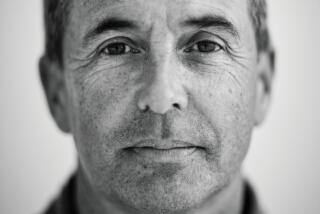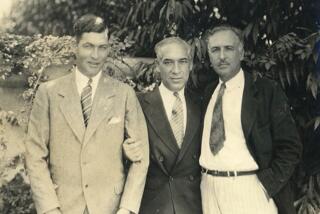Will ‘The End of the Tour’ warp the way we think about David Foster Wallace?
David Foster Wallace was a larger-than-life figure even before he committed suicide in September 2008 at age 46. By then, he’d published two novels, including the 1,079 page “Infinite Jest,” as well as several volumes of essays and short fiction concerned with the minutiae of consciousness, what it meant to occupy one’s own life.
In many ways, his perspective — an idiosyncratic mix of cultural engagement and reticence — offered a model of how a writer might operate in an increasingly distracted world. How to deal with overload? Embrace it. But embrace it smartly, with full awareness of its contradictions and its lures.
Such a sensibility sits at the center of both Wallace’s fiction and nonfiction; “Infinite Jest” revolves in part around a film so all-consuming that its viewers can do nothing else but watch until they die.
“Make no mistake,” he wrote in his 1993 essay “E Unibus Pluram”: “we are dependent on image-technology; and the better the tech, the harder we’re hooked.”
It’s also central to “The End of the Tour,” the new film featuring Jason Segel as Wallace and Jesse Eisenberg as journalist David Lipsky, who spent five days in 1996 with the author — at home in Bloomington, Ill., and doing bookstore and media events — for a Rolling Stone feature that never materialized; their interviews were later developed into Lipsky’s 2010 book “Although of Course You End Up Becoming Yourself: A Road Trip with David Foster Wallace.”
There’s an irony to this, for “The End of the Tour” is all about our relationship to image, both in the story it tells, of a writer at the very moment he became an icon, and also in the way it tells that story. The movie makes this explicit by framing its main narrative as extended flashback, a memory play provoked by Wallace’s death. It gives the action a bittersweet, nostalgic edge it did not have — could not have had — in actual life.
And yet, that raises the question, doesn’t it, of what it means to see Wallace portrayed as a character in a film? “A writer who courted contradiction and paradox,” Christian Lorentzen described him this month in New York magazine, “who could come on as a curmudgeon and a scold, who emerged from an avant-garde tradition and never retreated into conventional realism, he has been reduced to a wisdom-dispensing sage on the one hand and shorthand for the Writer As Tortured Soul on the other.”
Lorentzen’s right — Wallace was a study in incongruities: compassionate yet also critical, empathetic and dismissive, obsessive but at times overblown. Add to that his observation that “Wallace started the process” of his own mythologizing, and we begin to see the complexities that energized and enervated him, the notion of an author locked in conversation, or even mortal combat, with himself.
This is what “The End of the Tour” aspires to trace, revolving as it does around the tension between the private and the public individual. Wallace invites Lipsky into his home, where the reporter catalogues everything (what is hanging on the walls, what is in the medicine cabinet). Both are always aware that their conversation, their relationship, is a contrivance, and yet that it might also yield something real.
At one point, Wallace digs into the experience of depression, the way it makes him feel both better (by allowing him to see through the illusion of meaning, of purpose) and worse (by rendering him nonfunctional) than everyone else. That he never uses the word “depression” is fitting, since he tended to be circumspect about his mental state.
Still, it is impossible not to bring what we know about the author — of his life and death, yes, but also of his writing — to this moment, and indeed to the entire film.
As for how this affects our appreciation of Wallace, I don’t know the answer. Throughout his career, he was a challenging writer, expansive, consumed by ambiguities, doubling back on his own arguments, his own narratives. (There’s a reason “Infinite Jest” concludes with nearly 100 pages of endnotes.)
In “A Supposedly Fun Thing I’ll Never Do Again” — his novella-length piece of reportage, first published in Harper’s, about a week on a cruise ship — he takes us from judgment to consideration in his portrayals of his fellow passengers.
“I have seen fuchsia pantsuits and pink sport coats and maroon-and-purple warm-ups and white loafers worn without socks,” he writes. “… I have heard upscale adult U.S. citizens ask the ship’s Guest Relations Desk whether snorkeling necessitates getting wet, whether the trapshooting will be held outside, whether the crew sleeps on board, and what time the Midnight Buffet is.”
What Wallace is describing is a kind of desperation, a desperation that repels him but to which he relates. This is the key to his writing, the way he keeps surprising not just us but also himself.
“The End of the Tour” does not traffic in such complexities; that is not its intent. It’s more interested in the interplay between Wallace and Lipsky, or Segel and Eisenberg. As we watch, both wrestle with the interview, its curious mix of intimacy and distance, and also with the requirements of publicity, “[t]he whole going around and reading in bookstores thing,” which, Lorentzen reports, Wallace believed was “turning writers into kind of penny-ante or cheap versions of celebrities.”
Such a tension brings us back to Wallace’s creative project: image versus substance yet again.
“My whole life, I’ve been a fraud,” he begins his devastating short story “Good Old Neon.” “I’m not exaggerating. Pretty much all I’ve ever done all the time is try to create a certain impression of me in other people. Mostly to be liked or admired.”
The twist is that in admitting this, he also undermines it, reveals his authenticity. Irony? Maybe, but in the end, that seems too easy. Better, I’d suggest, to call it living: portrait of the artist as a human being.
twitter: @davidulin
MORE:
David Foster Wallace movie: Can it overcome family objections?
When Paul Thomas Anderson studied with David Foster Wallace
How ‘End of the Tour’ became a very David Foster Wallace kind of film
More to Read
Sign up for our Book Club newsletter
Get the latest news, events and more from the Los Angeles Times Book Club, and help us get L.A. reading and talking.
You may occasionally receive promotional content from the Los Angeles Times.








